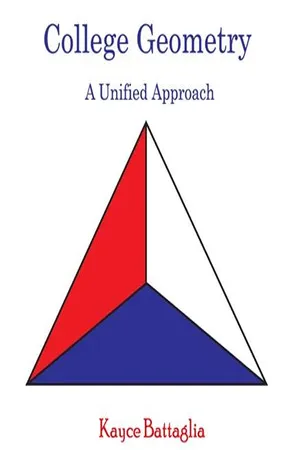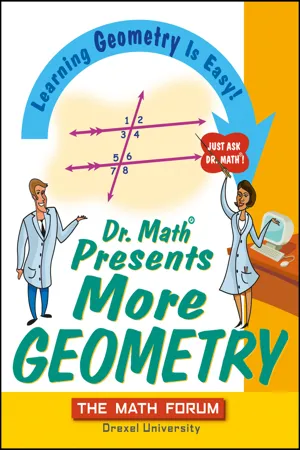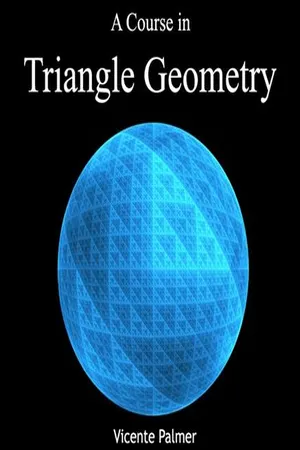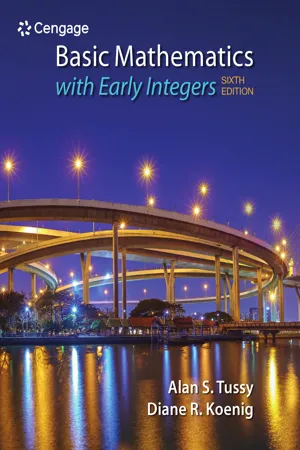Mathematics
SSS Theorem
The Side-Side-Side (SSS) theorem is a principle in geometry that states if the three sides of one triangle are congruent to the three sides of another triangle, then the two triangles are congruent. This theorem is a fundamental concept in proving the equality of two triangles based on their side lengths.
Written by Perlego with AI-assistance
Related key terms
1 of 5
7 Key excerpts on "SSS Theorem"
- No longer available |Learn more
College Geometry
A Unified Approach
- (Author)
- 2014(Publication Date)
- Orange Apple(Publisher)
If triangle ABC is congruent to triangle DEF, the relationship can be written mathematically as: In many cases it is sufficient to establish the equality of three corresponding parts and use one of the following results to deduce the congruence of the two triangles. The shape of a triangle is determined up to congruence by specifying two sides and the angle between them (SAS), two angles and the side between them (ASA) or two angles and a corresponding adjacent side (AAS). Specifying two sides and an adjacent angle (SSA), however, can yield two distinct possible triangles. ________________________ WORLD TECHNOLOGIES ________________________ Determining congruence Sufficient evidence for congruence between two triangles in Euclidean space can be shown through the following comparisons: • SAS (Side-Angle-Side): If two pairs of sides of two triangles are equal in length, and the included angles are equal in measurement, then the triangles are congruent. • SSS (Side-Side-Side): If three pairs of sides of two triangles are equal in length, then the triangles are congruent. • ASA (Angle-Side-Angle): If two pairs of angles of two triangles are equal in measurement, and the included sides are equal in length, then the triangles are congruent. The ASA Postulate was contributed by Thales of Miletus (Greek). In most systems of axioms, the three criteria— SAS , SSS and ASA —are established as theorems. In the School Mathematics Study Group system SAS is taken as one (#15) of 22 postulates. • AAS (Angle-Angle-Side): If two pairs of angles of two triangles are equal in measurement, and a pair of corresponding non-included sides are equal in length, then the triangles are congruent. • RHS (Right-angle-Hypotenuse-Side): If two right-angled triangles have their hypotenuses equal in length, and a pair of shorter sides are equal in length, then the triangles are congruent. - eBook - PDF
Dr. Math Presents More Geometry
Learning Geometry is Easy! Just Ask Dr. Math
- (Author)
- 2005(Publication Date)
- Jossey-Bass(Publisher)
But we have several theorems (or postulates) that say we don’t have to check every part; it’s enough to check just three parts, if we choose the right three. Specifically, the following: SSS tells us that if each side of one matches the correspon- ding side of the other, then the triangles are congruent. ASA tells us that if two angles of one match the correspon- ding angles of the other and the sides between those angles match, then the trian- gles are congruent. SAS tells us that if two sides of one match the correspon- ding sides of the other and the angles between them match, then the triangles are congruent. 70 Dr. Math Presents More Geometry Now, it is not enough to say that a pair of angles look the same; you have to know they are. Typically in geometry proof, you are told (or know for other reasons) that certain parts are congruent. For example, you might be told in this figure that PQ is the same length as RS and ∠PQS has the same measure as RSQ. You know without having to be told that any segment is congruent to itself, so QS ≅ SQ. So if we think about triangles PQS and RSQ (with the letters given in the order we want to compare them), we can turn the latter around in our minds so that they line up with the letters in corre- sponding spots like this: Now we have three pairs of matching parts: PQ ≅ RS ∠PQS ≅ ∠RSQ QS ≅ SQ And these are in the order SAS, with the angle between the sides. So the SAS theorem tells us that the two triangles are congruent. We don’t have to know anything about the other side and angles; it’s like saying that if the left ears match, the right ears will match, too, so we don’t need to check them. —Dr. Math, The Math Forum Triangles: Properties, Congruence, and Similarity 71 P S Q R Q P S S R Q Hi, Qian, For many combinations of side-side-angle, two triangles will be con- gruent. But there are instances when this isn’t enough information to determine a unique triangle. - No longer available |Learn more
- Daniel C. Alexander, Geralyn M. Koeberlein, , , Daniel C. Alexander, Geralyn M. Koeberlein(Authors)
- 2014(Publication Date)
- Cengage Learning EMEA(Publisher)
Look again at Example 2. If a “different” triangle were constructed by choosing to be the first side, it would be congruent to the triangle shown; however, it might be necessary to flip or rotate it to have corresponding vertices match. The objective of Example 2 is that it provides a method for establishing the congruence of triangles by using only three pairs of their parts. If corresponding angles are measured in the given triangle and in the constructed triangle with the same lengths for sides, these pairs of angles will also be congruent! SSS (METHOD FOR PROVING TRIANGLES CONGRUENT) AC BC AC 124 CHAPTER 3 ■ TRIANGLES Unless otherwise noted, all content on this page is © Cengage Learning. A C M D B The four triangular panes in the octagonal window are congruent triangles. Geometry in the Real World If the three sides of one triangle are congruent to the three sides of a second triangle, then the triangles are congruent (SSS). POSTULATE 12 The designation SSS will be cited as a reason in the proof that follows. Each letter of SSS refers to a pair of congruent sides. EXAMPLE 3 GIVEN: and bisect each other at M (See Figure 3.4.) PROVE: PROOF Statements Reasons NOTE 1: In Steps 2 and 3, the three pairs of sides were shown to be congruent; thus, SSS is cited as the reason that justifies why . NOTE 2: is the image determined by the clockwise or counterclockwise rotation of about point M through a 180° angle of rotation. The two sides that form an angle of a triangle are said to include that angle of the triangle. In in Figure 3.5(a), sides and form ; therefore, and include . In turn, is said to be the included angle for and Similarly, any two angles of a triangle must have a common side, and these two angles are said to include that side. In , and share the common side ; therefore, and include the side ; equivalently, is the side included by and . ∠ T ∠ U UT UT ∠ T ∠ U UT ∠ T ∠ U TUV TV . TU ∠ T ∠ T TV TU ∠ T TV TU TUV AMC BMD AMC BMD AMC BMD AC DB CD AB Figure 3.4 1. - eBook - PDF
- Daniel C. Alexander, Geralyn M. Koeberlein(Authors)
- 2019(Publication Date)
- Cengage Learning EMEA(Publisher)
Each letter of SSS refers to a pair of congruent sides. 3.1 ■ Congruent Triangles 139 U T V (a) A C B (b) Figure 3.5 Informally, the term include names the part of a triangle that is “between” two other named parts. In a triangle, two sides include an angle, while two angles include a side. The two sides that include the angle actually form the angle. The two angles that include a side share that side. EXAMPLE 4 In uni2206ABC of Figure 3.5(b): a) Which angle is included by AC and CB ? b) Which sides include uni2220B? c) What is the included side for uni2220A and uni2220B? d) Which angles include CB ? SOLUTION a) uni2220C (because this angle is formed by AC and CB ) b) AB and BC (because these sides form uni2220B) c) AB (because it is the common side for uni2220A and uni2220B) d) uni2220C and uni2220B (because CB is a side of each angle) SAS (METHOD FOR PROVING TRIANGLES CONGRUENT) A second way of establishing that two triangles are congruent involves showing that two sides and the included angle of one triangle are congruent to two sides and the included angle of a second triangle. If two people each draw a triangle so that two of the sides mea- sure 2 cm and 3 cm and their included angle measures 54°, then those triangles are con- gruent. See Figure 3.6. POSTULATE 13 If two sides and the included angle of one triangle are congruent to two sides and the included angle of a second triangle, then the triangles are congruent (SAS). The order of the letters SAS in Postulate 13 helps us to remember that the two sides that are named have the angle “between” them; that is, the two sides referred to by S and S form the angle, represented by A. In Example 5 on page 140, the two triangles to be proved congruent share a common side; the statement PN _ PN is justified by the Reflexive Property of Congruence, which is conveniently expressed as Identity. - eBook - PDF
Mathematics for Elementary Teachers
A Contemporary Approach
- Gary L. Musser, Blake E. Peterson, William F. Burger(Authors)
- 2013(Publication Date)
- Wiley(Publisher)
Is Roberto correct? Discuss. GEOMETRIC PROBLEM SOLVING USING TRIANGLE CONGRUENCE AND SIMILARITY The two parallelograms below have congruent corresponding sides, but the parallelograms themselves are not congruent. The two tri- angles below have congruent corresponding sides and, by the SSS triangle congruence, the triangles are congruent. These two ideas are related to some principles of fence building. When building a gate for a fence, a crosspiece (A), like the one shown, is added to ensure a stron- ger more stable gate that won’t sag. Why does the diagonal (A) add so much strength that the two parallel pieces (B and C ) couldn’t provide? How is this strengthening crosspiece related to the SSS triangle congruence? 766 Chapter 14 Geometry Using Triangle Congruence and Similarity Applications of Triangle Congruence In this section we apply triangle congruence and similarity properties to prove properties of geometric shapes. Many of these results were observed informally in Chapter 12. Our first result is an application of the SAS congruence property that establishes a property of the diagonals of a rectangle. Problem-Solving Strategy Draw a Picture Show that the diagonals of a rectangle are congruent. SOLUTION Suppose that ABCD is a rectangle [Figure 14.50(a)]. Figure 14.50 A B D C AC = BD (a) A B D C (b) Then ABCD is a parallelogram (from Chapter 12). By a theorem in Section 14.1, the opposite sides of ABCD are congruent [Figure 14.50(b)]. In particular, AB DC ≅ . Consider nABC and n n DCB; ABC C ≅ ∠D B, since they are both right angles. Also, CB BC ≅ . Hence, n n ABC DCB ≅ by the SAS congruence property. Consequently, AC BD ≅ , as desired. ■ The next result is a form of a converse of the theorem in Example 14.11. In parallelogram ABCD, if the diagonals are congruent, it is a rectangle. SOLUTION Suppose that ABCD is a parallelogram with AC BD ≅ [Figure 14.51(a)]. Figure 14.51 Since ABCD is a parallelogram, AD BC ≅ . - No longer available |Learn more
- (Author)
- 2014(Publication Date)
- Learning Press(Publisher)
(The included angle for any two sides of a polygon is the internal angle between those two sides.) • If three corresponding sides of two triangles are in proportion, then the triangles are similar. Two triangles that are congruent have exactly the same size and shape: all pairs of corresponding interior angles are equal in measure, and all pairs of corresponding sides have the same length. (This is a total of six equalities, but three are often sufficient to prove congruence.) Some sufficient conditions for a pair of triangles to be congruent are: • SAS Postulate: Two sides in a triangle have the same length as two sides in the other triangle, and the included angles have the same measure. • ASA: Two interior angles and the included side in a triangle have the same measure and length, respectively, as those in the other triangle. (The included side for a pair of angles is the side that is common to them.) • SSS: Each side of a triangle has the same length as a corresponding side of the other triangle. • AAS: Two angles and a corresponding (non-included) side in a triangle have the same measure and length, respectively, as those in the other triangle. • Hypotenuse-Leg (HL) Theorem: The hypotenuse and a leg in a right triangle have the same length as those in another right triangle. This is also called RHS (right-angle, hypotenuse, side). • Hypotenuse-Angle Theorem: The hypotenuse and an acute angle in one right triangle have the same length and measure, respectively, as those in the other right triangle. This is just a particular case of the AAS theorem. - Alan Tussy, Diane Koenig(Authors)
- 2018(Publication Date)
- Cengage Learning EMEA(Publisher)
Due to electronic rights, some third party content may be suppressed from the eBook and/or eChapter(s). Editorial review has deemed that any suppressed content does not materially affect the overall learning experience. Cengage Learning reserves the right to remove additional content at any time if subsequent rights restrictions require it. CHAPTER 9 • An Introduction to Geometry 758 14. Name the six corresponding parts of the congruent triangles shown below. S T E 3 in. 4 in. 4 in. 3 in. 5 in. 5 in. R F G Fill in the blanks. 15. Two triangles are if and only if their vertices can be matched so that the corresponding sides and the corresponding angles are congruent. 16. SSS property: If three of one triangle are congruent to three of a second triangle, the triangles are congruent. 17. SAS property: If two sides and the between them in one triangle are congruent, respectively, to two sides and the between them in a second triangle, the triangles are congruent. 18. ASA property: If two angles and the between them in one triangle are congruent, respectively, to two angles and the between them in a second triangle, the triangles are congruent. Solve each proportion. 19. x 15 H11005 20 3 20. 5 8 H11005 35 x 21. h 2.6 H11005 27 13 22. 11.2 4 H11005 h 6 Fill in the blanks. 23. Two triangles are similar if and only if their vertices can be matched so that corresponding angles are congruent and the lengths of corresponding sides are . 24. If the angles of one triangle are congruent to corresponding angles of another triangle, the triangles are . 25. Congruent triangles are always similar, but similar triangles are not always . 26. For certain application problems, similar triangles and can be used to find lengths that would normally be difficult to measure. NOTATION Fill in the blanks. 27. The symbol H11061 is read as “ .” 28. The symbol H11011 is read as “ .” 8. a. Draw a triangle that is congruent to ^CDE shown below.
Index pages curate the most relevant extracts from our library of academic textbooks. They’ve been created using an in-house natural language model (NLM), each adding context and meaning to key research topics.






